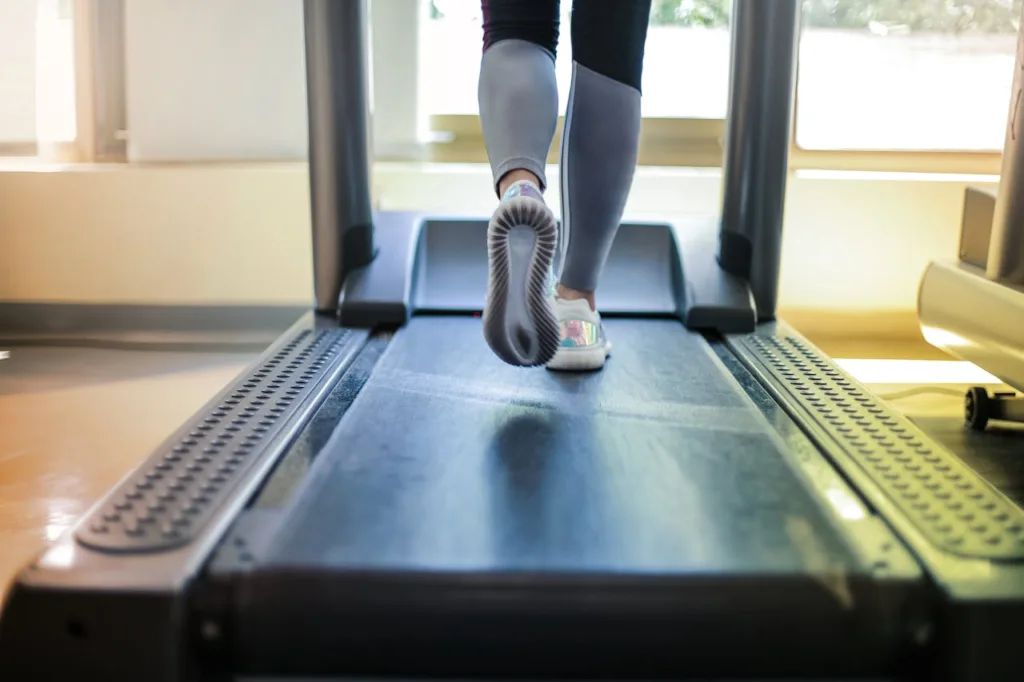Taking care of your treadmill is essential for keeping it running smoothly and extending its lifespan. By regularly maintaining your machine, you can prevent unwanted breakdowns and improve your workout experience, making it safer and more effective.
In this handy guide, we’ll walk you through a thorough treadmill maintenance checklist that covers everything from daily care to bi-annual inspections. Just follow these straightforward steps, and you’ll ensure your treadmill stays in fantastic shape for all your running and walking adventures.

Table of Contents
1. Wipe Down the Treadmill (Weekly)
After each workout, gently wipe the belt, handrails, and console with a soft, damp cloth. Taking this small step helps remove sweat and dust, which can cause parts to wear down over time and lead to performance issues. Regularly cleaning your treadmill is a simple yet important way to keep it looking its best and functioning smoothly.
Tip: Avoid using harsh cleaners. A mild soap solution works best.
2. Check the Safety Key and Emergency Stop (Weekly)
Ensure the safety key is securely attached and check that the emergency stop button works. These safety features are essential during workouts, particularly if you lose your balance or need to stop abruptly.
3. Visually Inspect for Debris (Weekly)
Take a moment to check around and under the treadmill for any small debris, such as dirt, dust, or loose items. Keeping an eye on this is important because if debris is left unchecked, it could be pulled into the motor area or cause uneven wear on the belt.
Tip: Keep the area around your treadmill clean and clutter-free.
4. Vacuum Around and Under the Treadmill (Weekly)
Dust and dirt can accumulate around your treadmill, potentially getting drawn into the motor or beneath the belt. To maintain a clean motor and ensure the belt operates smoothly, use a vacuum cleaner to clear dust from the surrounding area and underneath the treadmill.
Tip: Unplug the treadmill before vacuuming underneath it for safety.
5. Check the Belt Alignment (Weekly)
Ensure the treadmill belt is centered and moves straight without contacting the sides. If you observe the belt veering to one side, it requires realignment. A misaligned belt can cause uneven wear, affecting your running experience.
Tip: Most treadmills have easy-to-adjust screws at the back to fine-tune the belt position.
6. Inspect the Power Cord and Plug (Weekly)
Take a moment to examine the power cord and plug closely. Check for any signs of wear, fraying, or damage. If you notice a damaged cord, replace it right away to keep everything running smoothly and safely.
7. Lubricate the Treadmill Belt (Monthly)
As time goes by, the friction between the belt and the deck can build up, which might put extra strain on the motor and cause parts to wear out more quickly. By applying lubrication, you can help reduce that friction and prolong the life of both the belt and the motor!
Tip: Always refer to your treadmill’s user manual for the appropriate lubricant type and instructions. Some treadmills come pre-lubricated and don’t require additional oil.
8. Tighten Bolts, Screws, and Fasteners (Monthly)
If you use your treadmill regularly, you might notice that some bolts and screws can loosen over time because of the vibrations. It’s a good idea to take a moment to inspect all the visible bolts and fasteners, giving them a gentle tighten to ensure everything stays stable and safe for your workouts!
Tip: Avoid over-tightening, which can strip threads or damage parts.
9. Clean the Motor Cover and Internal Parts (Monthly)
Dust and debris can settle inside the motor cover, which might cause overheating or affect performance. If your model allows, gently remove the motor cover and use a vacuum or a soft brush to carefully clean out any dust that has accumulated.
Tip: Make sure the treadmill is unplugged before opening any covers.
10. Inspect the Treadmill Belt for Wear and Tear (Quarterly)
As time goes by, you might find that the treadmill belt can stretch, thin out, or even develop some rough spots. It’s a good idea to keep an eye out for fraying edges, uneven wear, or any signs of the belt slipping. If you see any serious damage, don’t worry—it’s time to consider replacing the belt!
Tip: A properly maintained belt should feel smooth and run evenly without jerking.
11. Check Motor Brushes (Quarterly)
Some treadmills come with motor brushes that can wear down with regular use. If your treadmill features accessible motor brushes, it’s a great idea to check them for any signs of wear and replace them when needed to ensure your motor keeps running smoothly!
Tip: Always consult your owner’s manual or a professional if you’re unsure about checking motor parts.
12. Test the Shock Absorption System (Quarterly)
Treadmills often come with special cushioning systems designed to help lessen the impact on your joints, which is great for your comfort! But just like anything else, these systems can wear out over time. So, keep an eye out for any reduced bounce or noticeable sagging.
If you notice a firmer impact while you’re running, it might be time to repair or replace the cushioning to keep your workouts enjoyable and safe.
We highly recommend consulting the user manual that comes with your treadmill, particularly if you’re a new owner or using it for the first time! It’s packed with helpful tips to ensure everything runs smoothly, and many treadmill manufacturers provide all the information you’ll need to keep your machine in top shape.
Signs Your Treadmill Needs Immediate Attention
Even with regular treadmill maintenance, problems can still pop up from time to time. By recognizing early warning signs, you can help prevent minor issues from blossoming into costly repairs or dangerous situations. Here are some important signs that your treadmill needs a little extra love and attention:
Strange Noises During Operation
If you hear unusual sounds, such as squeaking, grinding, or thumping, while your treadmill is running, it could mean there’s a problem with the belt, motor, or rollers. These noises aren’t normal, so it’s a good idea to have them checked out as soon as possible.
Tip: Stop using the treadmill immediately if you hear grinding sounds to avoid further damage.
Burning Smells
If you notice a burning odor while using the treadmill, it may indicate motor issues, belt friction, or even electrical problems. It’s very important to prioritize your safety, so ensure you unplug the treadmill and contact a professional for assistance immediately.
Belt Slipping or Hesitation
If you notice the treadmill belt slipping, hesitating, or stuttering while you walk or run, it may be a sign that it is too loose or worn out. It’s really important to address this quickly to avoid any falls or serious injuries.
Console Errors or Malfunctions
If you’re seeing flashing error messages, experiencing screen freezing, or dealing with unresponsive buttons, these could be signs of potential electrical issues. Don’t worry, as these problems usually require more than basic treadmill maintenance and may need professional servicing to get everything back on track!
Visible Wear and Tear
Signs such as frayed belts, cracked side rails, loose handrails, or a sagging deck indicate that your treadmill requires repairs or parts replacement. Overlooking these visible damages may render the machine unsafe for use.
Treadmill Repair Companies
| Company | URL | Country |
|---|---|---|
| Fitness Machine Technicians | https://fitnessmachinetechnicians.com/ | Over 100 Territories |
| UK GYM Repair | https://www.uk-gym-repair.co.uk/ | UK |
| Fitness Experience | https://fitnessexperience.ca/pages/new-locations | Canada |
| Service First | https://servicefirst-tx.com | USA |
Why Treadmill Maintenance is Important?
Taking care of your treadmill is crucial for maintaining its safety, efficiency, and longevity. When you neglect regular maintenance, even the best treadmills can encounter problems that may lead to breakdowns, costly repairs, or even injuries during your workouts. Let’s explore the top reasons why treadmill maintenance is something you don’t want to overlook:

Prevents Safety Risks
A treadmill that isn’t well-maintained can pose some risks. If the belt is worn out, parts are loose, or the emergency stop button isn’t working correctly, it could lead to falls or injuries. By performing regular maintenance on your treadmill, you can ensure that everything functions smoothly, creating a safer and more enjoyable exercise experience every time you use the machine!
Extends the Life of Your Treadmill
Treadmills are a valuable addition to any home gym! By doing routine maintenance, such as keeping the belt clean, lubricating the moving parts, and checking for loose bolts, you can help prevent early wear and tear.
Improves Performance
Dust and debris, along with insufficient lubrication, can make your treadmill feel less smooth. You may notice the belt slipping, the motor struggling, or the display being a bit slow. By maintaining your treadmill regularly, you’ll help it run at its best, ensuring a smoother, quieter, and much more enjoyable workout experience overall.
Reduces Repair Costs
Taking care of your treadmill is essential to keep it running smoothly! If you neglect maintenance, minor issues might snowball into major setbacks. For example, a dry belt could wear out the motor, and an unaligned belt can lead to costly damage.
Maintains Warranty Protection
Many treadmill warranties require proof of regular maintenance, so keeping a close eye on your treadmill is key! If you don’t take care of it, you might accidentally void the warranty, which means you’ll be responsible for any repairs. By correctly maintaining your treadmill, you can help ensure that your warranty stays valid if anything unexpected happens.
Pro Tips for Treadmill Longevity
Consistent treadmill upkeep is essential, but adopting a few savvy practices can extend its lifespan. These straightforward tips will safeguard your investment and ensure smooth, safe workouts for years ahead:
- Use a Surge Protector: Treadmills come equipped with delicate electronics that can be adversely affected by power surges. To keep your treadmill safe from unexpected electrical spikes, plug it into a surge protector.
- Keep the Treadmill in a Clean, Dry Environment: Moisture, dust, and extreme temperatures can reduce your treadmill’s lifespan. Place your treadmill indoors, away from windows, bathrooms, or dusty garages.
- Follow the manufacturer’s instructions: Each treadmill has its unique features. It’s a great idea to check your user manual for specific maintenance tips, such as when to lubricate it, how to adjust the belt tension, and which cleaning products to use, to keep it in top shape.
- Avoid Overloading the Treadmill: Check the weight limit and stay within it. Overloading can strain the motor, deck, and belt, resulting in faster wear and expensive repairs.
- Schedule Professional Servicing: Taking good care of your treadmill with regular DIY maintenance is fantastic! However, it’s a great idea to have a professional technician give it a thorough inspection and service at least once a year, particularly if you use it frequently.
Conclusion
Regularly caring for your treadmill is a great way to protect your investment, ensure your safety, and enjoy a smoother workout. Whether it’s as simple as a daily wipe-down or a more thorough inspection every few months, every little bit of maintenance helps keep your treadmill running like new.
Maintaining a regular treadmill maintenance checklist not only extends the life of your machine but also prevents costly repairs and helps you maximize your fitness routine. Whether you enjoy a leisurely walk or go all out as a serious runner, taking care of your treadmill ensures it’s always ready for you whenever you’re ready to use it!
Why not add just a few minutes of maintenance to your workout routine starting today? Your treadmill (and your future self) will be so grateful!
Frequently Asked Questions (FAQs)
How often should I perform treadmill maintenance?
To keep your treadmill in tip-top shape, it’s a great idea to go through a maintenance checklist every one to three months, depending on how often you hop on for a workout. If you’re using it daily or weekly, you’ll want to give it some extra love by inspecting and cleaning it more often!
What should be included in a treadmill maintenance checklist?
To keep your treadmill in top shape, make sure to include cleaning the belt and deck, lubricating the belt, checking for any loose bolts or screws, inspecting the motor area, and ensuring the machine is on a level surface. Taking a little time to do these tasks can enhance your workout experience!
Do all treadmills need lubrication?
Yes, most treadmills require regular lubrication unless stated otherwise in the user manual. Lubricating the belt decreases friction and prolongs the lifespan of both the motor and the belt.
Can I use household cleaners on my treadmill?
Avoid using harsh household cleaners. Instead, use a soft cloth along with mild soap and water or a cleaner specifically designed for treadmills to prevent damage to the belt and electronic components.
Why is my treadmill making noise even after maintenance?
If you’re hearing unusual noises after finishing your treadmill maintenance checklist, it could mean that the belt is too tight, misaligned, or that there’s a little trouble with the motor. It’s a good idea to double-check the alignment or reach out to a technician for help! if the noise persists.





